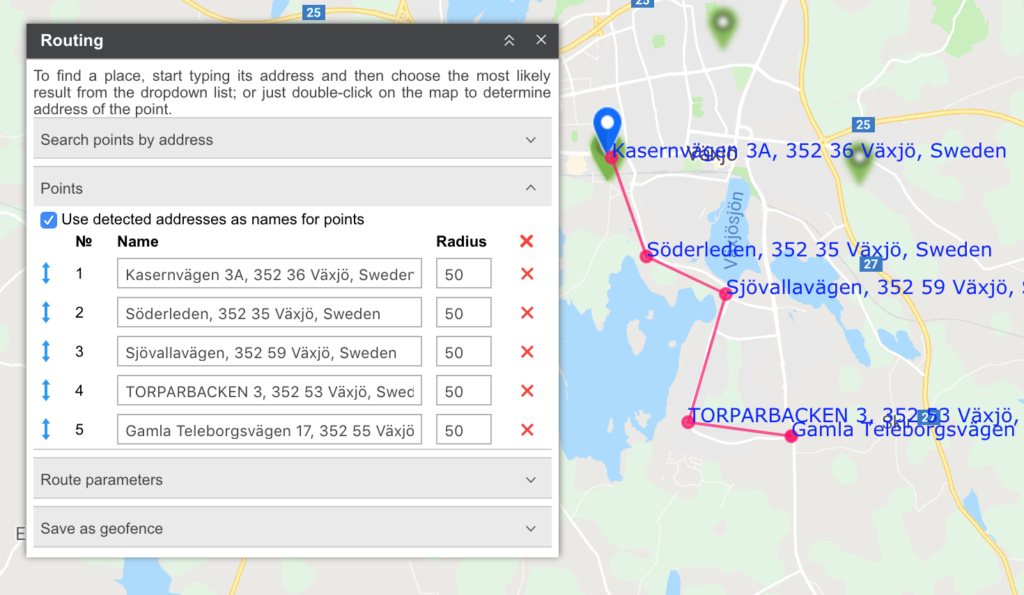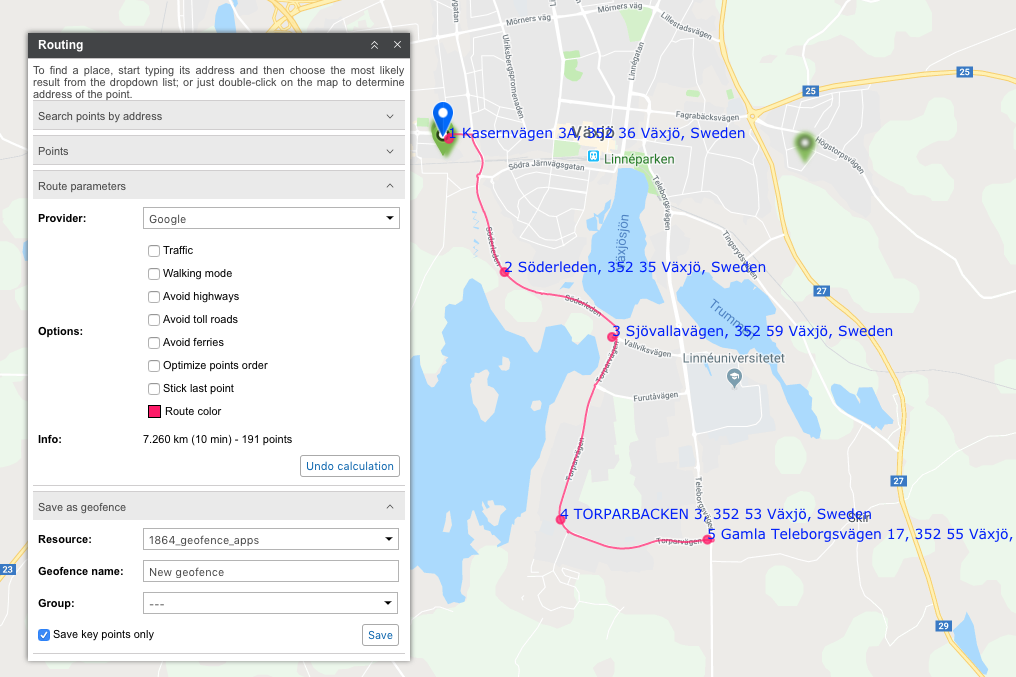The Routing tool tool helps to quickly make routes from one point to another visiting any number of intermediate points. You can define the sequence of points yourself or the program will optimize it for you. You can indicate key points double-clicking on the map or entering needed addresses. Resulting route can be either saved as a geofence with or without control points, or a route, and can be used for routes control or geofences control later on.
Choose Tools –> Routing to make use of this feature. Set points and click Calculate.
Provider Selection
GoogleMaps is a default cartographical service for making a route. Besides, depending on the maps available at your service, other map providers can also be used: Google, Yandex, HERE, etc. However in this case the order of points should be chosen manually (or previously determined using Google Maps). Some providers offer additional options. For example, if Google is selected, the route can be mapped regarding the way you travel: by car (default option), or walking, or avoiding highways (tick the appropriate check box). Yandex adds possibility to take into account traffic jams.
Points Placement
There are two basic ways to set key points for route:
-
-
With the mouse.
Just make several double-clicks on the map to mark key points. If the option Use detected addresses as names for points is enabled in the Points panel, then address information is set as point name. If no address information is available, the point is added anyway but with empty name.
-
-
With the address tool.
In the Address panel indicate addresses to be visited (city, street, house). The usage of the Address tool was described in details in the previous section. The found points can be added to the route automatically (if the box Auto save of points is checked), or manually (with the Add point button if the box is not checked).
![]() Note.
Note.
If you are going to use this route for Route Control, it is recommended to enter departing point as the first point of the route.
When all points are set, it is possible already to draw the route (the Calculate button). However, before doing that, you can edit key points, especially if you are going to save this route as geofence or as a route.
The list of points is displayed in the Points panel. Here you can edit point name, its radius, and delete unnecessary point.

Route Calculation
Upon building a route with Google Maps, different sequence of route points may be used:
-
-
Default option is that the points follow in the order you put them.
-
-
To build the shortest way of passing route points, enable the Optimize points order checkbox. In this case the 1st route point is fixed, and a route is laid without snapping to roads. The last point can be fixed either (for example, if a unit leaves the depot and after a while comes back), therefore regardless to the sequence of route passing, the last point indicated is the last route point as well. For this, enable the flag Stick last point.
At the end, click the Calculate button and estimate the result. If you need to change some parameters (for example, add more points), click Undo calculation. If you want to build a new route, remove all points using the corresponding button special button (on the Points tab of the instrument).
In addition, you can choose line color as well as view information about a route — its length, approximate route duration, and number of points.
If the calculation is made using routing, then the route will be built considering the existing roads. Google Maps is supported as default routing provider for this instrument.

Saving as Geofence or Route
After the calculation and visualization has been done, the result can be saved either as a line-shaped geofence or as a route. Geofence saving section is automatically opened after calculation by default. Here you should enter the geofence name, choose a resource and a geofence group (if you want to include the created geofence in an existing group) and click the Save button. There are two variants for saving in this section:
-
-
If the Save key points only box is checked, a geofence corresponds to a line going straight through the key points;
-
-
If the flag is not activated, then geofence corresponds to the full line of a route (can contain any number of points).
The newly created geofence appears on the Geofences panel where it can be edited and used for different purposes.
As it was mentioned before, the result can also be saved as a route. To do so, it is necessary to unfold the corresponding section, indicate a name for the route, and click Save. The created route appears in the Routes panel where it could be edited or used.
To build a route, you can also make use of a specially designed app — Delivery Service.
